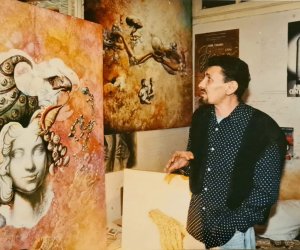How to live with 100 voices inside your head

Hearing multiple inner voices was once treated as a sign of psychosis – but could we learn deeper truths by listening to what they say? In an edited extract from his new book, psychologist Charles Fernyhough explores a radical new approach to mental illness.
"I don’t know. It sounds daft, but sometimes he says things that are really funny.”
The speaker is Margaret, a woman in her seventies with a bright, open face and a gentle smile. She has come along today with her daughter, who is desperate for advice on helping her mother to cope with her frequent voices. There are around 20 of us in the room . Apart from a couple of clinical psychologists and a few of us from the academic team, everyone gathered here in a conference suite at Durham University on a cold, sparkling spring afternoon, is a voice-hearer. We are hosting the event with our special guest Jacqui Dillon, chair of the UK Hearing Voices Network and an old friend of our project.
. Apart from a couple of clinical psychologists and a few of us from the academic team, everyone gathered here in a conference suite at Durham University on a cold, sparkling spring afternoon, is a voice-hearer. We are hosting the event with our special guest Jacqui Dillon, chair of the UK Hearing Voices Network and an old friend of our project.
 . Apart from a couple of clinical psychologists and a few of us from the academic team, everyone gathered here in a conference suite at Durham University on a cold, sparkling spring afternoon, is a voice-hearer. We are hosting the event with our special guest Jacqui Dillon, chair of the UK Hearing Voices Network and an old friend of our project.
. Apart from a couple of clinical psychologists and a few of us from the academic team, everyone gathered here in a conference suite at Durham University on a cold, sparkling spring afternoon, is a voice-hearer. We are hosting the event with our special guest Jacqui Dillon, chair of the UK Hearing Voices Network and an old friend of our project."Yeah, mine say funny things, too.”
Before Margaret came into this room, she had never met another voice-hearer. Now she is surrounded by them. I see her deep in conversation with Julia, a writer of a similar age who has come to talk to us several times about her experiences. Two elderly ladies, sipping tea and chatting about the voices in their heads. Julia is an old hand, but Margaret is in entirely new territory. She looks radiant, transformed. I have the sense that a life could be changing in front of my eyes.
Groups like this come together around a starting assumption that voices are meaningful, and that they convey valuable emotional messages. The idea that voices can have profound human significance has deep roots, featuring, for example, in the psychoanalyst Carl Jung’s argument that hallucinations contain a "germ of meaning” which, if identified accurately, can mark the beginning of a process of healing. The idea is antithetical to the traditional biomedical view from psychiatry, which has tended to see voices as neural junk, meaningless glitches in the brain – yet many people are now finding solace in this approach.
In Eleanor Longden’s gripping and heart-rending book, Learning from the Voices in My Head, based on her popular TED talk, she describes how her psychotic breakdown as a student led to a diagnosis of schizophrenia, from which she was told there would be no recovery. The first voice that Longden heard was benign, commenting on her actions in the third person: "She is leaving the building.” "She is opening the door.” When Longden mentioned her voice to a friend, the beginnings of a positive relationship with the voice began to unravel. Longden was urged to seek medical help, and her college doctor referred her to a psychiatrist – the beginning of a journey from a straight-A student to cowering, degraded psychiatric patient. One consultant psychiatrist told Longden that she would have been better off with cancer than schizophrenia, "because cancer is easier to cure”.
Like countless others, Longden has benefited from the alternative framework of understanding that the Hearing Voices Movement has given her. After her grim days in hospital, she was seen by an enlightened psychiatrist, Pat Bracken, who helped her to understand her voices not as symptoms of disease but as survival strategies. She had been brutalised by her experiences, and her psyche was struggling to adapt. Longden began to understand her voices as resulting from the horrific and organised sexual torture she had suffered as a small child. "It was a blasphemy,” she wrote of her abuse, "a desecration beyond expression; and it left behind a tiny child whose mind broke and shattered into a million tiny pieces.” Longden grew into an academically successful, organised young woman who became adept at presenting a serene face to the world. Behind the façade, though, was a mind torn apart by a "psychic civil war”.
tiny pieces.” Longden grew into an academically successful, organised young woman who became adept at presenting a serene face to the world. Behind the façade, though, was a mind torn apart by a "psychic civil war”.
 tiny pieces.” Longden grew into an academically successful, organised young woman who became adept at presenting a serene face to the world. Behind the façade, though, was a mind torn apart by a "psychic civil war”.
tiny pieces.” Longden grew into an academically successful, organised young woman who became adept at presenting a serene face to the world. Behind the façade, though, was a mind torn apart by a "psychic civil war”.With Bracken’s help, Longden resolved to make sense of her voices. She learned of the Dutch psychiatrist Marius Romme’s claim that voices are messengers communicating important information about unresolved emotional problems. In Romme’s metaphor, it makes no sense to shoot the messenger just because the content of the message is unpleasant. Instead, the Hearing Voices Movement approach is to encourage voice-hearers to try to understand the events that led to the emotional distress that the voices are expressing. "The question we should be asking,” Longden says, "is not ‘What’s your problem?’ It’s ‘What’s your story?’”
The movement has its origins in a particular therapeutic partnership between Romme and one of his patients, a young Dutch woman named Patsy Hage. As a conventionally trained physician, Romme’s instinct was to see Hage’s destructive, troubling voices as meaningless symptoms of a biomedical illness. But Hage insisted that her voices were as real and significant as the deities to whom those around her prayed. She was influenced by Julian Jaynes’s theory of how our ancestors in the era of the Iliad experienced the gods speaking to them, and she was reassured by the closeness of her experience to what Jaynes claimed was once the default mode of thought. As she put it to Romme, her epiphany in understanding her alien voices was a simple realisation: "I’m not a schizophrenic, I’m an ancient Greek!”
Romme’s view of his patient started to change, and he began to take her testimony more seriously. When they appeared together on Dutch television to discuss the work they had been doing and to appeal for voice-hearers to contact them, there was an overwhelming response. Around 150 of the people who contacted them had found ways of living contentedly with their voices. As the movement grew, its basic tenets began to cohere: that hearing voices is a common aspect of human experience, which can be distressing but is not inherently a symptom of illness; and that voices bear messages about emotional truths and problems which can, through taking the voices seriously and with appropriate support, be resolved.
At first glance, this looks utterly different to the idea that voices result from atypical processing of inner speech. Rather than pointing us to the processing of language and the speech perception networks in the brain, it suggests that we should look for a link with traumatic memories. Clinically, and from the evidence of personal testimony, this makes perfect sense. What scientific support, though, is there for the idea that voices are about memories of the past?
One way of addressing this question is to ask whether those who hear voices show any differences in how they process memories. Flavie Waters and her colleagues at the University of Western Australia have proposed that auditory hallucinations result from a failure to inhibit memories that are not relevant to what the person is currently doing. The idea, which has gained support from Waters’ experimental studies, is that people who have such experiences are particularly bad at keeping irrelevant information out of consciousness. Coupled with a problem with context memory – which refers to the ability to recall the details of the context in which an event happened – this can lead to memories intruding into consciousness shorn of the contextual anchors that would usually allow us to recognise them as a memory rather than a hallucination. Another line of evidence comes from associations with trauma. There is now very strong evidence for a link between hearing voices and early adversity, particularly childhood sexual abuse. In one recent study led by Richard Bentall, childhood rape was strongly and specifically associated with hallucinations later in life. To give an indication of the strength of the relationship, Bentall likened it to that between smoking and lung cancer.
(BBC)
www.ann.az
Latest news 
More news 



































 Photo
Photo 



 Video
Video 

